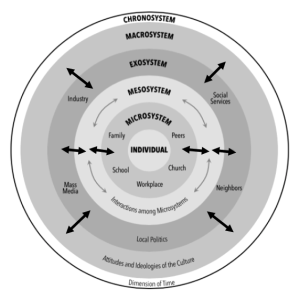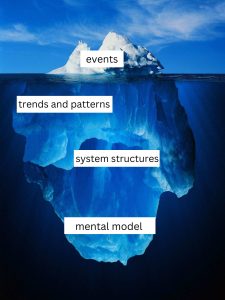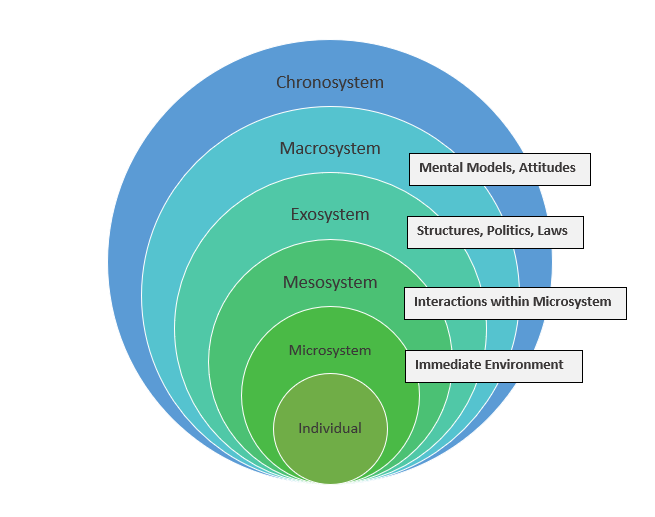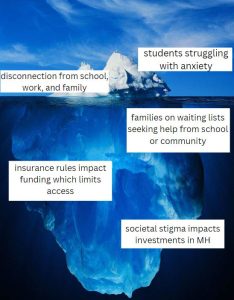6 Systems Thinking
Systems thinking is a framework for understanding and addressing social problems and is founded on the principles of Bronfenbrenner’s Ecological Theory. The framework focuses on the relationship between the parts of the system (micro, meso, exo, macro, chronosystem) instead of the individual system levels or environments.
The general idea of systems thinking is that every problem needs to be analyzed by examining it systemically and identifying the systemic levels and the relationship between them. If we re-examine the Ecological Systems Theory graphic from the previous section, this version highlights that the examination is not about the system as a whole but about the interaction and relationship between the levels, as shown with the darker arrows.

In other words, systems thinking is a method of analysis to understand how the systems function and what type of feedback and influence is likely to be exchanged between system levels, providing a framework for what should be the focus of the social change work.
Using the Ecological Map
An ecological map is in itself an extremely useful tool in order to understand the context of a community and to provide critical insight to individuals at the center of the ecological system who likely experience a problem or issue in intense ways and may feel responsible for their experience.
An initial step in applying systems thinking is to name the parts of the ecological system that can influence or be influenced by subsystems. You can identify a specific community (sharing geography or identity) and begin to name and define the components of the ecological system that represents the community, writing them directly on the map.
As you are working with individuals, it helps to share insights from this ecological perspective to demonstrate that they exist in a larger context and their experience is impacted by layers of influence. This in itself could be helpful to alleviate the complete burden of responsibility but also demonstrate their potential influence and agency.
Analyzing Forces Between Subsystems
The iceberg metaphor helps explain the necessity of examining the problem and the system in order to effectively analyze it. The iceberg demonstrates that what we see as evidence of a problem represents just the systems and not the forces, structures, or mindsets that perpetuate the problem. In order to address the complex problem we need to understand the ways it appears, is perpetuated, and reinforced. These levels are events, trends and patterns, system structures, and mental models/maps.
Next, you will see an image that combines the two graphics: Ecological Systems Theory and the Systems Thinking Iceberg. This highlights where we are focusing our analysis on in the system. You will notice that on the tip of the iceberg are the behaviors or observations we make about individuals, but it is the attitudes and mental models of the macro system that we really need to understand because of their profound influence on the rest of the system.
The questions to ask in order to gain the insights represented by the iceberg metaphor include:
- What is the evidence of the problem? How is this visible? What do we see?
- This insight is provided at the center of the ecological system and often by the people who are directly experiencing a problem or represent the problem as most people describe it.
- For example, “Students are struggling with anxiety.”

- What are trends and patterns that are also visible? What are the organizations that are responsible for addressing or are impacted by the trends?
- This is typically the way people describe the impact of the problem.
- The answer is found in the microsystem and mesosystem.
- For example “Student anxiety is leading to their disconnection from school and higher truancy rates.“
- What are the institutions, structures, or policies that influence or are impacted by the problem?
- These institutions often are already concerned about the problem and experience a sense of responsibility but are often unclear on their role or opportunity in addressing a problem.
- These can be found in the exosystem.
- For example, “The student and family health insurance rules limit access to care that would be helpful in addressing their anxiety.”
- What are the mindsets, attitudes, or cultural norms that impact how people see the problem?
- These are the aspects of culture that aren’t visible but that impact the entire context of the ecological system.
- These can be found in the macrosystem.
- For example, “The stigma about mental health impacts demands greater health insurance access and parity with physical health.”

Let’s apply systems thinking to an example of a local mental health project. In this scenario, we are applying systems thinking to understand the in-depth causes of some of the student anxious behaviors that were being observed and causing concern with teachers and families. We need to understand the systemic influences on a student’s mental well-being. Using the iceberg metaphor, here is a graphic showing examples of how systems thinking could highlight underlying causes by understanding the interactions between parts of the system. This information is gathered by reviewing different types of data, including surveys (like student surveys), community public health data, as well as interviewing students, school mental health professionals, and community mental health professionals, parents, and community leaders.

The analysis of this graphic should highlight the strong influence that societal stigma has on the extent to which we are investing in mental health services, including the extent to which health insurance covers mental health services, and the continuum of services that exist in a community. If there is limited access to critical services, such as mental health, it is likely that children will be placed on a waiting list for support instead of being able to access the help when it is needed. When children cannot access help when it is needed, then it is likely that their symptoms of mental health are likely to become worse before they become better, increasing the likelihood of struggle and a negative impact on their lives like sleep, concentration, sense of hopefulness, etc.